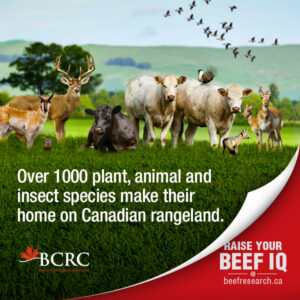How Much Water is Used to Make a Pound of Beef?
Facts about water use and other environmental impacts of beef production in Canada
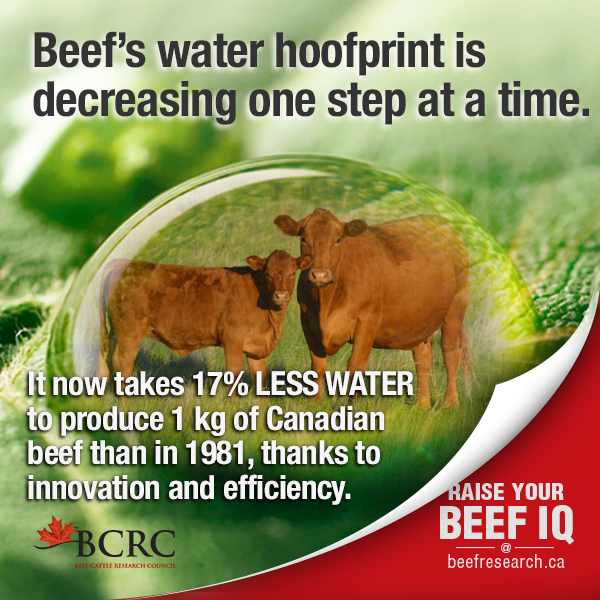
Yes, it takes water to produce beef, but in the 2.5 million years since our ancestors started eating meat, we haven’t lost a drop yet.
Based on the most recent science and extensive calculations of a wide range of factors, it is estimated that the pasture-to-plate journey of this important protein source requires about 1,910 US gallons per pound (or 15,944 litres per kilogram) of water to get Canadian beef to the dinner table. That’s what is known as the “water footprint” of beef production.
That may sound like a lot, but the fact is it doesn’t matter what crop or animal is being produced; food production takes water. Sometimes it sounds like a lot of water, but water that is used to produce a feed crop or cattle is not lost. Water is recycled – sometimes in a very complex biological process— and it all comes back to be used again.
Water requirements vary with animal size and temperature. But on average, a 1250 pound (567 kg) beef steer only drinks about 10 gallons (about 38 litres) of water per day to support its normal metabolic function. That’s pretty reasonable considering the average person in Canada uses about 59 gallons (223 litres) per day for consumption and hygiene. And according to the most recent Statistics Canada data, Canada’s combined household and industrial use of water is about 37.9 billion cubic meters annually (a cubic meter equals about 220 gallons or 1000 litres of water) — we humans are a water-consuming bunch.
Researchers at the University of Manitoba and Agriculture and Agri-Food Canada (AAFC) Lethbridge found that in 2011, producing each unit of Canadian beef used 17% less water than 30 years prior.(1) It also required 29% less breeding stock, 27% fewer harvested cattle and 24% less land and produced 15% less greenhouse gases to produce each pound or kilogram in 2011 compared to 1981.(2)
But back to the beef industry — agriculture in general and beef producers specifically have often been targeted as being high consumers, even “wasters” of water, taking its toll on the environment. However, there’s a lot more to this story – it’s not as simple as 1,910 gallons of water being used for each pound of edible beef produced.

If the beef animal itself only needs about 10 gallons of water per day to function, what accounts for the rest of the water (footprint) required for that 16 oz steak? Often in research terms the water measured in the total water footprint is broken into three colour categories. The footprint includes an estimate of how much surface and ground (blue) water is used to water cattle, make fertilizer, irrigate pastures and crops, process beef, etc.
And then there is a measure of how much rain (green) water falls on pasture and feed crops, and finally how much water is needed to dilute runoff from feed crops, pastures and cattle operations (grey water). Adding these blue, green and grey numbers for cattle produced throughout the world produces a global “water footprint” for beef. It is worth noting that more than 95% of the water used in beef production is green water — it is going to rain and snow whether cattle are on pasture or not. And it is important to remember of all water used one way or another it all gets recycled.
If you look at the life cycle of a beef animal from birth to burger or pasture to pot-roast, the 1,910 gallons per pound is accounting for moisture needed to grow the grass it will eat on pasture and for the hay, grain and other feeds it will consume as it is finished to market weight. It also reflects the water used in the processing and packaging needed to get a whole animal assembled into retail cuts and portion sizes for the consumer. Every step of the process requires water.
Since the objective is to produce protein, couldn’t we just grow more pulse crops such as peas, beans, lentils and chickpeas and still meet protein requirements, use less water and benefit the environment? Let’s take a look at why that theory doesn’t hold true.
Water is just part of a very large picture

First of all, whether it is an annual crop (such as wheat, canola or peas) or some type of permanent or perennial forage stand (like alfalfa or bromegrass) consumed by cattle, all crops need moisture to grow. (And as we talk about different crops in the next few paragraphs, it is important to note there are two main types. Most field crops such as wheat, barley and peas are annual plants. They are generally seeded in the spring, get harvested in the fall and then die off as winter sets in. Most pasture and forage crops are permanent or perennial plants. Native or natural grass species seemingly live forever, while tame or domestic forage species will remain productive for at least two or three years and often for many years before they need to be reseeded.)
Both annual crops and forages are important in Canadian agriculture. But, when people wonder why we just don’t produce more plant-based protein by growing more peas, beans and lentils, it’s not just a matter of swapping out every acre of pasture to produce a field of peas. It’s a matter of playing to your strengths — recognize the potential of the land for its best intended purpose.

Annual pulse crops (like peas, beans and lentils) use more water than grass. For dry pea production, for example, it takes about 414,562 gallons of water per acre of land to grow peas. Compare that to total Canadian beef production of about 2.46 million pounds of beef produced on about 57 million acres land to grow the pasture, forage and other feed for the cattle herd, and it works out to about 78,813 gallons per acre of land used for beef production. This means that not every acre beef cattle are raised on is suited to crop production. Dry peas need more than five times as much water per acre (414,652 ÷ 78,813 = 5.3) than the grass does. Much of the land used to raise forage for beef cattle doesn’t receive adequate moisture or have the right soil conditions to support crop production, but it can produce types of grass that thrives in drier conditions.
Beef industry plays an important diverse role
The fact is, today’s beef cattle were not the first bovid species to set foot on what we now consider Canadian agricultural land. For thousands and thousands of years herds of as many as 30 million bison roamed across North America, including Canada, eating forages and depositing nutrients (manure) back into the soil and living in ecological harmony with thousands of plant and animal species.

Today, the five million head of beef cattle being raised on Canadian farms can’t duplicate that natural system, but as they are managed properly they do provide a valuable contribution to the environment just as the bison did. Beef cows and the pastures they use help to preserve Canada’s shrinking natural grassland ecosystems by providing plant and habitat biodiversity for migratory birds and endangered species, as well as habitat for a host of upland animal species. Properly managed grazing systems also benefit wetland preservation, while the diversity of plants all help to capture and store carbon from the air in the soil.
Where do cattle fit?

Forages (pastures and harvested roughage) account for approximately 80 percent of the feed used by beef cattle in Canada. Nearly a third (31 percent) of Canada’s agricultural land is pasture. This land is not suited for annual crop production, but it can grow grass, which needs to be grazed by animals to remain growing and productive.
Canada’s beef herd is primarily located in the prairies. The southern prairies are drought-prone, and the more northerly growing seasons are too short for many crops. Central and Eastern Canada generally have higher rainfall and longer growing seasons than the prairies, but not all this farmland is suitable for crop production either. Much of this land is too boggy, stony, or bushy to allow cultivation, but it can grow grass. Grass that cattle live on for most of their lives.
Grass and other range and pasture plants contain fiber that people can’t digest, but cattle have a specialized microbial population in their stomach (rumen) that allows them to digest fiber, make use of the nutrients and convert them into high-quality protein that humans can digest. Beef cattle production allows us to produce nutritious protein on land that isn’t environmentally or climatically suited to cultivation and crop production.
Water cycles
Simply focusing on water use per pound of product ignores the water cycle. The water cycle is important – humans, wheat, corn, lentils, poultry, pork, eggs, milk, forages and beef production all use water, but they don’t use it up. They aren’t sponges that endlessly absorb water. Nearly all the water that people or cattle consume ends up back in the environment through manure, sweat, or water vapor.
We know that most of the water plants take up from the soil is transpired back into the air. Like city water, the water that beef processing facilities take out of the river at one end of the plant is treated and returns to the same river at the other end of the plant. New technologies to recycle and re-use water can reduce the amount of water needed for beef processing by 90 percent.
Storing greenhouse gases
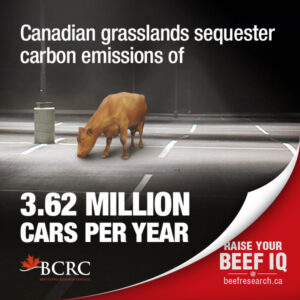
Plants — pasture and hayland, all crops really — help to capture and store carbon. Plants take carbon dioxide out of the atmosphere, incorporate the carbon into their roots, stems, leaves, flowers and seeds, and release oxygen back into the atmosphere. Because perennial plants (most hay and pastureland) live for many years, they develop an extensive root system which will eventually decay and become part of the soil carbon.
Because these permanent or perennial pastures are not cultivated and reseeded every year, the carbon sequestered by these plants remains in the soil rather than being released back into the atmosphere. As a result, numerous studies have documented that grasslands, which remain healthy with grazing cattle, have more carbon stored in the soil than adjacent annual cropland.
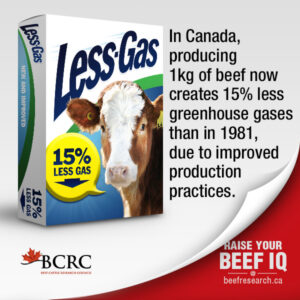
Pastures protect the soil
When land is cultivated to produce annual crops such as wheat, barley, canola, peas and lentils, the disturbance of soil releases soil carbon to the atmosphere. There is also the risk of soil erosion.
In Western Canada, our predecessors learned this the hard way. Not knowing any better about the impact of tillage of fields to produce crops, serious losses occurred across Canada —particularly notable on the prairies in the ‘Dirty Thirties’. Cultivation led to the loss of 40-50 percent of the organic carbon from prairie soils and 60-70 percent from central and eastern Canadian soils.
We learned from those mistakes and today, most annual crops are grown under reduced or no-till cropping systems — crops are seeded with minimal soil disturbance. Unlike commercial fertilizers, using manure as a fertilizer also replenishes organic matter in these soils.
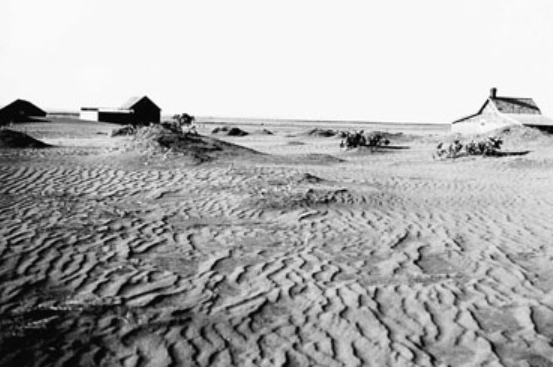
Maintaining permanent grassland and perennial pastures drastically reduces the risk of soil loss due to wind and water erosion, and keeps stored carbon stored in the soil. The point is that cattle have an excellent fit on productive agricultural land not suited to annual crop production.
Soil health improves
Getting back to the water topic, aside from benefits noted earlier, these permanent grasslands and perennial pastures in fact help to conserve moisture as roots and plant matter help to improve soil structure and help rain and snow melt percolate down through the soil. That’s known as water infiltration. As a general rule, when lands are left undisturbed, only 10 percent of precipitation runs off the land, 40 percent evaporates and 50 percent goes down into the soil to enter both shallow and deep groundwater reserves. When soils are disturbed, water infiltration is reduced.
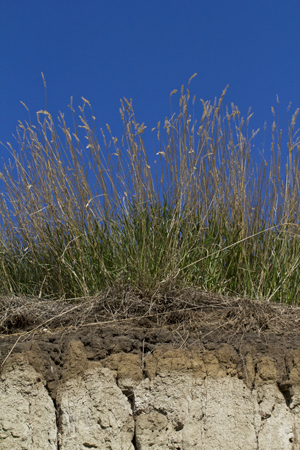
It’s not just dead roots that provide environmental benefits. Because perennial forages aren’t cultivated, and often grow in dry conditions, they grow extensive root systems in their search for moisture.
An example of one important plant species is the legume family. There are varieties of legumes that make excellent pasture and hay crops. They are known as forage legumes and most are perennial. But there is another whole branch of the legume family that humans consume at the dinner table. These legumes are known as pulse crops and that includes, peas, beans, lentils and chickpeas. Most annual pulse crops are used for human food, but even these produce by-products (e.g. stems, pods, shrivelled seeds, etc.) that are not edible for humans but that cattle can convert to high quality, nutritious protein.
What’s interesting about legumes is how they benefit the soil. For example, forage legumes like alfalfa develop roots that penetrate 53 to 63 percent deeper into the soil than chickpeas, lentils and other pulse crops. All legumes also have a natural ability to produce an important soil nutrient known as nitrogen. All legumes can “fix” or capture nitrogen from the air and convert it into soil nitrogen that can improve soil fertility. Forage legumes can fix up to twice as much nitrogen per acre in the soil as annual legume (or pulse) crop.
Lands that are prone to periodic flooding or drought benefit from the permanent plant cover that forages provide. The roots and vegetation keep the soil in place so that it doesn’t erode, wash away in a flood or blow away during a drought.
Home on the range
Again, when you ask the question, why don’t we just grow more annual crops, remember that cattle and soil aren’t the only living things affected when grassland is converted to farmland. Grasslands also provide habitat for small and large mammals, hawks, nesting birds, songbirds and pollinating insects. Converting natural grassland to crop production results in considerable biodiversity loss, as the native plants, insects, birds and wildlife that require undisturbed natural habitats do not thrive nearly as well under annual cropping systems.
Most of Canada’s native grasslands have already been converted to crop production. This has led to considerable population losses in some species, with up to 87 percent population declines among some grassland bird species. So maintaining grasslands and perennial pastures provides a huge ecological benefit.
Crops and cattle go well together
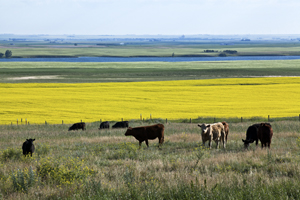
It is not an all or nothing scenario — crops, cattle and grasslands need each other. For example, canola crops yield and ripen better when they are pollinated by bees. Because an entire field is seeded at the same time, all the canola plants flower at the same time, and each plant only flowers for two or three weeks. Grasslands provide a home for a wide range of plants that all flower at different times. That means bees have lots of plants to help support them during long periods when annual crops aren’t flowering. Over 140 bee species are resident in Canadian grasslands; bee abundance and diversity are positively related to the presence of grasslands.

Annual crops can also serve double duty. Canadian farmers produced about eight million tonnes of barley in 2018. A portion of that was seeded to what’s known as malting barley varieties that produce barley suitable for the brewing industry. If the grain doesn’t meet specifications for brewing standards (for weather-related reasons, for example), it can still be used as good quality livestock feed. It’s a similar situation with the 32 million tonnes of wheat produced annually. If it doesn’t meet milling, export or other industrial end-use standards, it can be used as good quality feed for cattle.
All part of a system
To repeat, yes it takes water to produce beef, but on a broader scale, beef cattle are a vital part of an integrated system. Cattle need grass, grass needs grazing to remain vital, grass protects the soil, healthy soil helps to conserve moisture. Plants provide feed and habitat for a myriad of species, grains not suitable for the human-food market make excellent livestock feed and cattle manure provides a valuable natural fertilizer to pastures and crops. The whole system results in production of a high quality, healthy protein source for humans.
All food systems rely on water, but the most important thing to remember is the water is not used up. All water ultimately gets recycled.
Click here to subscribe to the BCRC Blog and receive email notifications when new content is posted.
The sharing or reprinting of BCRC Blog articles is welcome and encouraged. Please provide acknowledgement to the Beef Cattle Research Council, list the website address, www.BeefResearch.ca, and let us know you chose to share the article by emailing us at info@beefresearch.ca.
We welcome your questions, comments and suggestions. Contact us directly or generate public discussion by posting your thoughts below.
